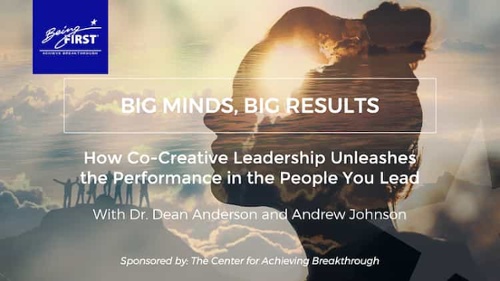Co-creating is a way of thinking and relating with others who are working toward the same outcomes. It is a simple and powerful approach that completely alters the terrain of political mine fields and competition. It's defined as individuals or teams working together across boundaries to do whatever is necessary to achieve WIN-Win-Win outcomes.
This teamwork enables people to direct their efforts toward a common objective, the Big Win, that everyone has committed to as their highest priority goal. That is key: committing first to something larger than your own agenda.
What It Looks Like to Co-Create
In a win-lose mindset, different departments or regions in your organization will fight for budget. In a co-creative mindset, you will each focus first on what resources are needed for the enterprise's highest success, and then, in partnership, figure out what that means for your own individual budget allocations. For example, one department or region might get more or less in any given quarter or year, depending on what is right for the enterprise's future. This does not mean that individuals or groups automatically need to sacrifice for the sake of the larger system. It simply means that each puts the needs of the larger enterprise first. Sometimes you get “the short end of the stick;” other times, the long end. But either way, what you get is what supports the larger enterprise’s needs—and that is the focus of co-creating.
Why Do It?
Coming from a WIN-Win-Win approach, if one of you is not getting your needs met, then the others engage co-creatively with you to find a new, more innovative solution. What’s the motivation to support others’ needs rather than compete for your own? Good reasons include:
- The larger system must succeed for each of you to survive over time, so orienting to it is key.
- You are stronger as teammates, mutually supporting each other.
- The larger system will succeed only to the degree each of you successfully contributes to it.
- You all must succeed for the enterprise to succeed.

Introducing this Approach to Your Organization
It’s one thing to understand co-creating in concept; it’s another to put it into practice with your leaders and peers. Be prepared for people to push back with “nice idea on paper, but that’s not how we do things around here!” It’s important to hear the comments and then to make the request to explore this concept as if it were a real possibility. It does take some personal development and it will change the corporate culture. Ask, “what would it look like if we all could operate this way?” Spend time painting the picture of the behaviors and requirements to make it work using a real project, with continued focus on the benefits of working this way. Have your people discuss how they would need to do things differently to gain the value of greater results with less politics and conflict. Then have them talk about how their relationships would need to be different, and how they could ensure that those changes had staying power. Good relationships are key to co-creating.
Improve the Mindset in Your Organization
To get a sense of the degree to which you are currently co-creating in your organization, and to begin to discover how to improve the mindset of co-creation, ask yourself the following questions:
1) To what degree do the key change leaders, executives, and change consultants:
- Understand the importance of strong partnerships when leading complex change?
- Understand the co-creative approach to change leadership?
- Understand how to share accountability to strengthen the effectiveness of working relations?
2) What is the current condition of the relationship among:
- People filling change leadership roles?
- Those in change leadership roles and those in functional/operational leadership roles?
- The change leaders and the external change consultants?
3) How will you secure the agreement of the executives and your external consultant vendors to operate co-creatively, especially if they are unaccustomed to working this way?
4) How can you strengthen the relationship between:
- The executive team and the change leadership team?
- The sponsor and the change process leader?
- The change process leader and change initiative leads?
- The internal and external change consultants?
5) How will the change leaders, executives, and change consultants establish agreements to review their working relationships to improve them over time and resolve any difficulties?
Making Sacrifices for the Big WIN
In a co-creative organization, if you cannot find a solution where everyone wins to some degree but some sacrifice must occur, then you share in the sacrifice as much as possible. Such cases will occur infrequently because your collective creativity and collaboration will usually generate a WIN-Win-Win solution where all objectives are met. When necessary, however, each party must be willing to sacrifice if the top priority, the Big Win, is best served by doing so.

